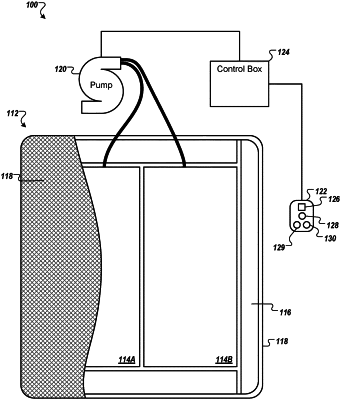| CPC A47C 21/04 (2013.01) [A61B 5/01 (2013.01); A61B 5/02055 (2013.01); A61B 5/1114 (2013.01); A61B 5/4809 (2013.01); A61B 5/4812 (2013.01); A61B 5/6892 (2013.01); A61B 5/747 (2013.01); A61M 21/02 (2013.01); G05B 13/042 (2013.01); A61B 5/021 (2013.01); A61B 5/02405 (2013.01); A61B 5/02444 (2013.01); A61B 5/0816 (2013.01); A61B 2560/0242 (2013.01); A61B 2562/0247 (2013.01); A61M 2021/0066 (2013.01); A61M 2021/0083 (2013.01); G05B 13/0265 (2013.01)] | 13 Claims |

|
1. A system for thermoregulation of a sleep environment, the system comprising:
a sensing unit configured to:
generate pressure readings from sensed pressure phenomena within the sleep environment; and
generate temperature readings from sensed temperature phenomena within the sleep environment;
a processing unit configured to:
receive the pressure readings and the temperature readings;
access circadian information that includes an indication of a circadian temperature cycle of a user that is sleeping in the sleep environment;
access sleep stage information that includes an indication of REM (Rapid Eye Movement) or NREM (Non-Rapid Eye Movement) status of the user;
determine, at a first time from the pressure readings and the temperature readings, a first wake-status of the user that identifies the user as having an awake wake-status;
determine, at a second time after the first time, a second wake-status of the user, that identifies the user as having a sleeping wake-status;
responsive to determining the second wake-status after the first wake-status and based on i) the circadian temperature cycle, ii) the pressure readings and the temperature readings, and iii) the sleep stage information, select, from a plurality of possible thermoregulation adjustments, a selected thermoregulation adjustment; and
alter a thermal property of the sleep environment based on the selected thermoregulation adjustment.
|